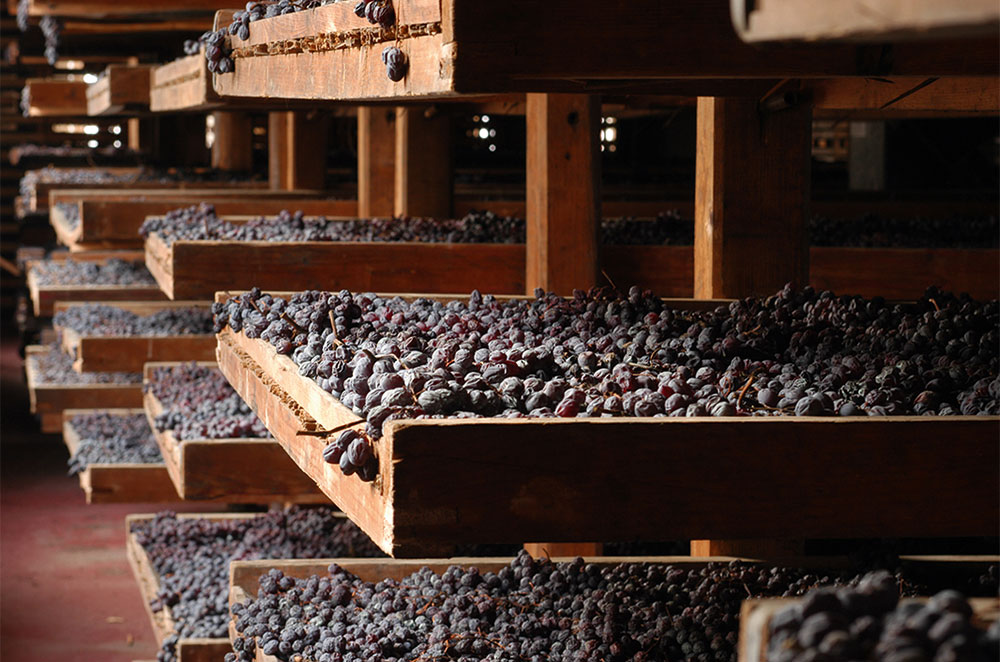Pumpkin soup? One might think to pair just about any other food than this with a big, full-bodied Amarone. A light, seasonal, almost vegetarian dish, if it weren’t for a slyly incorporated roast chicken liver (we’ll come back to this later ) matched to a muscular red wine with tremendous dry extract that touches 40 grams per litre, about 10g more than other powerful reds? Yet this pairing is not only one of the most provocative and novel achieved in the Valpolicella region, Amarone’s home, but also one of the greatest.
Why does pairing Amarone with food present such a challenge? The art of pairing wine with food aims to enlighten each morsel with a sip, avoiding the palate becoming saturated by rich dishes. The role of the wine is surely to measure up to the food’s richness, but also to contrast with or complement a recipe, in order to make the experience of both food and wine more memorable.
Scroll down for in-depth Amarone with food pairing recommendations plus eight great wines worth seeking out
Amarone’s traditional production process involves drying the grapes, laid out over wooden mats or strung up from the rafters in a special room in order to decrease water content while maximising sugar and acid levels, then fermenting almost to dryness.
Thanks to this, Amarone has high levels of dry extract; alcohol easily reaches 15% in these wines and can even hit 17% in some cases, resulting in full-bodied wines, often with some residual sugar and an off-dry style.

Naturally, such a wine requires rich foods to level with. The complexity of the blend – from local varieties Corvina, Corvinone, Rondinella, Molinara, Oseleta, with oak ageing over at least two years, though often up to nine or 10 for top examples – suggests Amarone ought to be matched with complex recipes.
Longer-aged releases are more common today than in the past, fostering a better integration of structure in the resulting wines. Extra ageing also enhances savouriness and complexity, which can easily overpower simple dishes.
{"content":"PGRpdiBjbGFzcz0iYnJlYWtvdXQgcGFsZXR0ZS1hIHBhbmVsIHBhbmVsLWRlZmF1bHQiPjxkaXYgY2xhc3M9InBhbmVsLWJvZHkiPjxkaXYgY2xhc3M9J2JyZWFrb3V0LWNvbnRlbnQnPjwvcD4KPGgzIHN0eWxlPSJ0ZXh0LWFsaWduOiBsZWZ0Ij48c3Ryb25nPkFtYXJvbmUgZGVsbGEgVmFscG9saWNlbGxhOiB0aGUgZ2VvZ3JhcGh5IGJlaGluZCB0aGUgd2luZXM8L3N0cm9uZz48L2gzPgo8cCBzdHlsZT0idGV4dC1hbGlnbjogbGVmdCI+QW1hcm9uZSwgdGhlIG1vc3QgZmFtb3VzIG9mIEl0YWx54oCZcyBkcnkgd2luZXMgbWFkZSBmcm9tIGRyaWVkIGdyYXBlcyAoYXMgb3Bwb3NlZCB0byBzd2VldCB3aW5lcyBtYWRlIGZyb20gZHJpZWQgZ3JhcGVzKSwgaXMgcHJvZHVjZWQgaW4gVmFscG9saWNlbGxhIG92ZXIgdGhlIG5vcnRoZXJuIGhpbGxzIG9mIFZlcm9uYSwgYmV0d2VlbiBMYWtlIEdhcmRhIGFuZCB0aGUgTGVzc2luaSBtb3VudGFpbnMgaW4gbm9ydGhlcm4gSXRhbHkuIEl0IGlzIHByZWNpc2VseSB0aGlzIGNvbWJpbmF0aW9uIG9mIGxha2UgYW5kIG1vdW50YWlucyB0aGF0IGNvbnRyaWJ1dGVzIHRvIHRoZSBwZXJmZWN0IGVudmlyb25tZW50IGZvciB0aGUgZ3Jvd2luZyBvZiBncmFwZXMgYW5kIHRoZSBkcnlpbmcgcHJvY2VzcyB0aGF0IGZvbGxvd3MuPC9wPgo8ZGl2IGNsYXNzPSJhZC1jb250YWluZXIgYWQtY29udGFpbmVyLS1tb2JpbGUiPgo8ZGl2IGlkPSJwb3N0LWlubGluZS0zIiBjbGFzcz0iaXBjLWFkdmVydCI+PC9kaXY+CjwvZGl2Pgo8cCBzdHlsZT0idGV4dC1hbGlnbjogbGVmdCI+VGhlIHJlZ2lvbiBpcyBsaWtlIGEgd2FycmVuIG9mIHZhbGxleXMgd2hlcmUgTGFrZSBHYXJkYSBtaXRpZ2F0ZXMgdGhlIGNsaW1hdGUsIGZvc3RlcmluZyB0aGUgbW9zdCBub3J0aGVybHkgb2xpdmUgb2lsIHByb2R1Y2VkIGluIEl0YWx5LCB3aGlsZSBNb250ZSBCYWxkbyBhbmQgdGhlIExlc3NpbmkgcmFuZ2UgcHJvdmlkZSBwcm90ZWN0aW9uIGFnYWluc3QgcHJldmFpbGluZyBjb2xkIGZyb20gdGhlIEVhc3Rlcm4gQWxwcy4gVGhpcyBlbnZpcm9ubWVudCBpcyBwYXJ0aWN1bGFybHkgdHJ1ZSBmb3IgdGhlIFZhbHBvbGljZWxsYSBDbGFzc2ljbyBzdWItcmVnaW9uIHRvIHRoZSB3ZXN0LCBjbG9zZXN0IHRvIExha2UgR2FyZGEsIGNvbXBhcmVkIHRvIFZhbHBhbnRlbmEgKGNlbnRyYWwpIGFuZCBWYWxwb2xpY2VsbGEgT3JpZW50YWxlIChlYXN0ZXJuKS48L3A+CjxwIHN0eWxlPSJ0ZXh0LWFsaWduOiBsZWZ0Ij5UaGUgQ2xhc3NpY28gYXJlYSBpcyBpbmZsdWVuY2VkIGJ5IHRoZSBsaWdodCByZWZsZWN0ZWQgZnJvbSB0aGUgd2F0ZXIsIHdoaWNoIGluY3JlYXNlcyB0aGUgcGhvdG9zeW50aGVzaXMgb2YgdGhlIHZpbmVzIGFuZCB0aGUgbWF0dXJpdHkgb2YgdGhlIGdyYXBlcy4gVGhlIGdyb3dpbmcgc2Vhc29uIGhlcmUgY2FuIGJlIHNob3J0ZXIgdGhhbiBpbiB0aGUgT3JpZW50YWxlLCB0aGUgcmVkIGZydWl0IG9mIHRoZSB3aW5lcyBldmVuIGJyaWdodGVyIGFuZCB0aGUgc3VnYXIgY29uY2VudHJhdGlvbiByaWNoZXIgaW4gYXJlYXMgc3VjaCBhcyBTYW504oCZQW1icm9naW8sIHdoaWNoIGhhcyBhIHdlc3Rlcm4gZXhwb3N1cmUgZGlyZWN0bHkgdG93YXJkcyB0aGUgbGFrZS48L3A+CjxkaXYgY2xhc3M9ImFkLWNvbnRhaW5lciBhZC1jb250YWluZXItLW1vYmlsZSI+CjxkaXYgaWQ9InBvc3QtaW5saW5lLTQiIGNsYXNzPSJpcGMtYWR2ZXJ0Ij48L2Rpdj4KPC9kaXY+CjxwIHN0eWxlPSJ0ZXh0LWFsaWduOiBsZWZ0Ij5GdW1hbmUsIGluIGNvbXBhcmlzb24sIGEgbGl0dGxlIHRvIHRoZSBub3J0aGVhc3Qgb2YgU2FudOKAmUFtYnJvZ2lvLCBpcyBrbm93biB0byBiZSBhIGNvb2xlciB2YWxsZXkgcHJvZHVjaW5nIGEgZnJlc2hlciwgYmxhY2sgY2hlcnJ5LWRyaXZlbiBzdHlsZSB3aXRoIGhpZ2hlciBhY2lkaXR5IGFuZCBhbiBpbnRlbnNlIGJsYWNrIHBlcHBlciBub3RlIHR5cGljYWwgb2Ygc2xpZ2h0bHkgdW5yaXBlIENvcnZpbmEgZ3JhcGVzLiBUaGUgY29tbXVuZSBvZiBOZWdyYXIsIGF0IHRoZSBlYXN0ZXJuIGVuZCBvZiBWYWxwb2xpY2VsbGEgQ2xhc3NpY28sIHNob3dzIGRhcmtlciBhbmQgcmljaGVyIGJyYW1ibGUgZnJ1aXRzIGFzIHdlbGwgYXMgYmxhY2sgcGVwcGVyLCB3aXRoIGFsbW9zdCBubyBjaGVycnkgYXQgYWxsLjwvcD4KPHAgc3R5bGU9InRleHQtYWxpZ246IGxlZnQiPlRoZSBzb2lsIGluIHRoZSBDbGFzc2ljbyBhcmVhIGlzIHZvbGNhbmljIGluIG9yaWdpbiBhbmQgY29tcG9zZWQgb2YgYSBsaW1lc3RvbmUgZG9sb21pdGUgc3RvbmUgbWl4IGFuZCBiYXNhbHQuIE1vcmUgdGhhbiBoYWxmIG9mIHRoZSBwcm9kdWN0aW9uIG9mIEFtYXJvbmUgd2luZSBjb21lcyBmcm9tIHRoZSB2aW5lcyBzaXR1YXRlZCBvbiB0aGUgaGlsbHMgdGhhdCB0aGUgcHJvZHVjZXJzIG9mIHRoZSBGYW1pZ2xpZSBTdG9yaWNoZSBncm91cCBjbGFpbSBhcmUgdGhlIG1vc3Qgc3VpdGFibGUgZm9yIHRoZSBwcm9kdWN0aW9uIG9mIENsYXNzaWNvIHdpbmUgb2YgdGhlIGhpZ2hlc3QgcXVhbGl0eS48L3A+CjxkaXYgY2xhc3M9ImFkLWNvbnRhaW5lciBhZC1jb250YWluZXItLW1vYmlsZSI+CjxkaXYgaWQ9InBvc3QtaW5saW5lLTUiIGNsYXNzPSJpcGMtYWR2ZXJ0Ij48L2Rpdj4KPC9kaXY+CjxwIHN0eWxlPSJ0ZXh0LWFsaWduOiBsZWZ0Ij5UaGUgZWFzdGVybiBWYWxwb2xpY2VsbGEgT3JpZW50YWxlIGFyZWEsIGhvd2V2ZXIsIGZyb20gTW9udG9yaW8gdG8gTW9udGVjY2hpYSBkaSBDcm9zYXJhLCBpbmNsdWRpbmcgdGhlIE1hcmNlbGxpc2UgYW5kIElsbGFzaSB2YWxsZXlzLCBpcyBiYXNlZCBtb3N0bHkgb24gY29sZGVyIG1vcmFpbmljIHNvaWwgYW5kIGhhcyBhIGxvbmdlciBncm93aW5nIHNlYXNvbiwgcHJvZHVjaW5nIG1vcmUgc3RydWN0dXJlZCB3aW5lcy4gVGhyb3VnaG91dCB0aGUgT3JpZW50YWxlLCB0aGVyZSBpcyBtb3JlIENvcnZpbm9uZSBwbGFudGVkLCB3aGljaCBhbHNvIGluY3JlYXNlcyB0aGUgc3RydWN0dXJlIG9mIHRoZSB3aW5lcy4gVGhpcyBpcyBjb21wYXJlZCB0byBWYWxwb2xpY2VsbGEgQ2xhc3NpY28sIHdoZXJlIHRoZSBzYW1lIGdyYXBlIGNhbiBsZW5kIHNwaWNpbmVzcyB0byB0aGUgd2luZSwgb3IgZXZlbiBhdCB0aW1lcyBhIGdyZWVuIGNoYXJhY3Rlci48L3A+CjwvZGl2PjxkaXYgY2xhc3M9J2JyZWFrb3V0LWJ1dHRvbnMnPjxkaXYgY2xhc3M9J3Jvdyc+PC9kaXY+PC9kaXY+PC9kaXY+PC9kaXY+Cjxocj4KPGgzIHN0eWxlPSJ0ZXh0LWFsaWduOiBsZWZ0Ij48c3Ryb25nPkFtYXJvbmXigJlzIGFyY2gtZW5lbWllczogZmF0dHkgZm9vZHMsIHBlcHBlcnkgaGVhdDwvc3Ryb25nPjwvaDM+CjxwIHN0eWxlPSJ0ZXh0LWFsaWduOiBsZWZ0Ij5UaGUgPHN0cm9uZz48YSBocmVmPSJodHRwczovL3d3dy5kZWNhbnRlci5jb20vbGVhcm4vdGFubmlucy00NTgxNC8iPnRhbm5pbnM8L2E+PC9zdHJvbmc+IGluIGJvdGgg4oCYcmVndWxhcuKAmSBWYWxwb2xpY2VsbGEgcmVkIHdpbmVzICh3aGljaCBhcmUgbWFkZSB1c2luZyB0aGUgc2FtZSByYW5nZSBvZiBncmFwZSB2YXJpZXRpZXMpIGFuZCBBbWFyb25lIGFyZSB0eXBpY2FsbHkgcm91bmQgYW5kIHNvZnQsIGFuZCB0aGlzIHNvZnRlciBleHRyYWN0aW9uIG9mIHRoZSB0YW5uaW5zIGlzIHRoZSBtYWluIGRpZmZlcmVuY2UgYmV0d2VlbiBDb3J2aW5hIGFuZCBwb3dlcmZ1bCBncmFwZXMgZm91bmQgaW4gb3RoZXIgSXRhbGlhbiByZWdpb25zLCBzdWNoIGFzIDxzdHJvbmc+PGEgaHJlZj0iaHR0cHM6Ly93d3cuZGVjYW50ZXIuY29tL3dpbmUvZ3JhcGUtdmFyaWV0aWVzL25lYmJpb2xvLyI+TmViYmlvbG88L2E+PC9zdHJvbmc+LCA8c3Ryb25nPjxhIGhyZWY9Imh0dHBzOi8vd3d3LmRlY2FudGVyLmNvbS93aW5lL2dyYXBlLXZhcmlldGllcy9zYW5naW92ZXNlLyI+U2FuZ2lvdmVzZTwvYT48L3N0cm9uZz4gYW5kIDxzdHJvbmc+PGEgaHJlZj0iaHR0cHM6Ly93d3cuZGVjYW50ZXIuY29tL3dpbmUvZ3JhcGUtdmFyaWV0aWVzL2FnbGlhbmljby8iPkFnbGlhbmljbzwvYT48L3N0cm9uZz4uPC9wPgo8cCBzdHlsZT0idGV4dC1hbGlnbjogbGVmdCI+QXN0cmluZ2VuY3kgW29mIHRhbm5pbl0sIGFsb25nc2lkZSBhY2lkaXR5LCB3b3JrcyB3ZWxsIGluIGNvbnRyYXN0aW5nIHRoZSBmYXR0aW5lc3Mgb2YgYSBkaXNoLiBBbWFyb25lIGhhcyBoaWdoIGFjaWQsIGJ1dCBpdHMgdGFubmlucyBhcmVu4oCZdCBlc3BlY2lhbGx5IGZpcm0sIGFuZCB0aGlzIG1lYW5zIGl0IGlzIGJlc3QgYXZvaWRlZCB3aXRoIG92ZXJ0bHkgZmF0dHkgcHJlcGFyYXRpb25zLjwvcD4KPHAgc3R5bGU9InRleHQtYWxpZ246IGxlZnQiPlRoZSB3aW5l4oCZcyBzbGlnaHQgcmVzaWR1YWwgc3VnYXIgYW5kIGl0cyBvdmVyYWxsIGNvbXBsZXhpdHkgY291bGQgaGVscCB0byBjb3VudGVyYWN0IDxzdHJvbmc+PGEgaHJlZj0iaHR0cHM6Ly93d3cuZGVjYW50ZXIuY29tL2xlYXJuL2FkdmljZS93aGF0LXMtdGhlLXdpbmUtc3R5bGUtZm9yLXNwaWN5LWZvb2RzLTUxMzk3LyI+c3BpY3kgZm9vZHM8L2E+PC9zdHJvbmc+OyBob3dldmVyLCBibGFjayBwZXBwZXIgb3IgcmVkIGNoaWxsaWVzIHRlbmQgdG8gaW5jcmVhc2UgdGhlIHBlcmNlcHRpb24gb2Ygd2FybXRoIGZyb20gdGhlIGFsY29ob2wsIGFuZCB0aGUgY29tYmluYXRpb24gY2FuIGFsbW9zdCBidXJuIHRoZSBwYWxhdGUuIFRoaXMgaXMgd2h5IEFtYXJvbmUgZG9lcyBub3QgcGxheSB2ZXJ5IHdlbGwsIGZvciBpbnN0YW5jZSwgd2l0aCBGaW9yZW50aW5hIHN0ZWFrIOKAkyB1bmxlc3MgaXQgaXMgc2Vhc29uZWQgd2l0aG91dCB0aGUgYmxhY2sgcGVwcGVyIHRoYXQgaXTigJlzIHRyYWRpdGlvbmFsbHkgc2VydmVkIHdpdGguPC9wPgo8aHI+CjxoMz48c3Ryb25nPlN1cnByaXNpbmdseSB2ZXJzYXRpbGU8L3N0cm9uZz48L2gzPgo8cD5TdGFydGluZyBmcm9tIGZpcnN0IHByaW5jaXBsZXMsIGFjY2VwdGluZyB0aGF0IGl04oCZcyBub3QgZ29pbmcgdG8gYmUgZHJ1bmsgYXMgYW4gYXBlcml0aWYgKHdoZXJlIHdvdWxkIHlvdSBnbyBmcm9tIHRoZXJlPyEpLCB0aGlzIHBvd2VyZnVsIHJlZCB3aW5lIHN0eWxlIHdvcmtzIHN1cnByaXNpbmdseSB3ZWxsIHdpdGggYSBWZW5ldG8gcmVjaXBlIGZvciBwdW1wa2luIHNvdXAgYW5kIHJvYXN0IGNoaWNrZW4gbGl2ZXIuIFRoZSBjcmVkaXQgZm9yIHRoaXMgcGFpcmluZyBnb2VzIHRvIEFkYSBSaW9sZmksIHRoZSBleHRyYW9yZGluYXJ5LCB3ZWxsLWtub3duIGFuZCBjdWx0dXJlZCBzb3VsIG9mIEVub3RlY2EgZGVsbGEgVmFscG9saWNlbGxhIGluIEZ1bWFuZS48L3A+CjxwPkFkYSBpcyB0aGUgd2lkb3cgb2YgUm9iZXJ0byBGZXJyYXJpbmksIHdobyB3YXMgYSBwaW9uZWVyIHdpbmVtYWtlciBvZiB0aGUgcmVnaW9uLiBGb3IgeWVhcnMgaGUgd29ya2VkIGFzIGEgY29uc3VsdGFudCBmb3IgbGVnZW5kYXJ5IGxhdGUgcHJvZHVjZXIgR2l1c2VwcGUgUXVpbnRhcmVsbGksIGFuZCB3b3JrZWQgd2l0aCBGcmFuY28gQWxsZWdyaW5pIHRvIGJ1aWxkIGEgZHJ5aW5nIGNlbnRyZSB3aXRoIGEgdmVudGlsYXRpb24gc3lzdGVtIHRvIGltcHJvdmUgQW1hcm9uZSBwcm9kdWN0aW9uLCBvdmVyY29taW5nIGJvdHJ5dGlzLWluZmVjdGVkIGdyYXBlcyBhbmQgYXZvaWRpbmcgdGhlIHJlc3VsdGluZyBveGlkaXNlZCBmbGF2b3VycyB3aGljaCBvbmNlIGNoYXJhY3RlcmlzZWQgdGhlIHdpbmVzLjwvcD4KPHA+QWZ0ZXIgc3BlbmRpbmcgYSBsaWZldGltZSB3aXRoIGhlciBodXNiYW5kLCBBZGEga25vd3MgZXZlcnkgcGxvdCBvbiB0aGUgaGlsbHMgYXJvdW5kIFZlcm9uYSwgY2FuIGRlc2NyaWJlIHRoZSBjaGFyYWN0ZXJpc3RpY3Mgb2YgYWxsIHRoZSBDb3J2aW5hIGdyYXBlcyBmcm9tIHRoZSBkaWZmZXJlbnQgdmFsbGV5cywgaXMgaW5mb3JtZWQgYWJvdXQgZXZlcnkgcHJvZHVjZXIg4oCTIGZyb20gdGhlIHNtYWxsIG9yZ2FuaWMgb25lcyB0byB0aGUgYmlnZ2VzdCBwbGF5ZXJzIG9mIHRoZSB3aW5lIGluZHVzdHJ5IOKAkyBhbmQgaXMgYSB0cnVlIGNvbm5vaXNzZXVyIG9mIHRoZSBjdWlzaW5lIG9mIFZhbHBvbGljZWxsYSBhbmQgaXRzIG1vc3QgZ3JhY2VmdWwgcGFpcmluZ3MuPC9wPgo8cD5TaGUgc3VnZ2VzdGVkIG1hdGNoaW5nIGhlciBzb3VwIG9mIHB1bXBraW4gKHByZWZlcnJpbmcgdGhlIG1hbnRvdmFuYSBvciBsb2RpZ2lhbmEgdmFyaWV0aWVzLCB3aGljaCBhcmUgc3dlZXRlciBhbmQgbGVzcyB3YXRlcnkpIHdpdGggYSBkcnkgQW1hcm9uZSBmcm9tIGEgY2xhc3NpYyBhcmVhIHdoZXJlIHRoZSBsaWdodGVyLCBtb3JlIGVsZWdhbnQgc3R5bGUgb2YgdGhlIHdpbmUgaXMgYW4gaWRlYWwgcGFydG5lciBmb3IgdGhlIGRpc2guIE9uZSBzdWNoIG9wdGlvbiBpcyBhIHRyYWRpdGlvbmFsbHkgc3R5bGVkIEFtYXJvbmUgd2l0aG91dCBvbGQtZmFzaGlvbmVkIGZ1bmt5IG5vdGVzOiBWaWxsYSBTcGlub3Nh4oCZcyBBbGJhc2luaSBmcm9tIEZpZ2FyaSBpbiBNYXJhbm8gZGkgVmFscG9saWNlbGxhIChDbGFzc2ljbyBhcmVhKS48L3A+CjxwPlRoaXMgbGlnaHRlciBzdHlsZSBvZiBBbWFyb25lIGlzIGFsc28gYSBnb29kIG1hdGNoIGZvciBsYXNhZ25ldHRlIHdpdGggcmFndcyALiBJbiB0aGlzIHJlZ2lvbiwg4oCYbGFzYWduZXR0ZeKAmSBkb2VzbuKAmXQgbWVhbiBsYXNhZ25lLCBhcyBvbmUgbWlnaHQgdGhpbmssIGJ1dCByYXRoZXIgaW1wbGllcyB0YWdsaWF0ZWxsZSDigJMgaGFuZC1tYWRlIGVnZyA8c3Ryb25nPjxhIGhyZWY9Imh0dHBzOi8vd3d3LmRlY2FudGVyLmNvbS9sZWFybi9kcmluay13aW5lLXdpdGgtcGFzdGEtZ3VpZGUtNDM1MDM4LyI+cGFzdGE8L2E+IDwvc3Ryb25nPm5vb2RsZXMgc2Vhc29uZWQgd2l0aCBtZWF0IHNhdWNlLiBPbmUgb2YgdGhlIGJlc3QgbGFzYWduZXR0ZSBpcyBmb3VuZCBhdCA8c3Ryb25nPjxhIGhyZWY9Imh0dHBzOi8vdHJhdHRvcmlhY2FwcmluaS5pdC8iIHRhcmdldD0iX2JsYW5rIiByZWw9Im5vb3BlbmVyIG5vcmVmZXJyZXIiPlRyYXR0b3JpYSBDYXByaW5pPC9hPjwvc3Ryb25nPiBpbiBUb3JiZSBkaSBOZWdyYXIsIHdoZXJlIHRoZSB3aW5lIGxpc3Qg4oCTIGp1c3QgbGlrZSBhdCBBZGHigJlzIGVub3RlY2Eg4oCTIGlzIGdvcmdlb3VzLjwvcD4KPGhyPgo8ZGl2IGNsYXNzPSJicmVha291dCBwYWxldHRlLWEgcGFuZWwgcGFuZWwtZGVmYXVsdCI+PGRpdiBjbGFzcz0icGFuZWwtYm9keSI+PGRpdiBjbGFzcz0nYnJlYWtvdXQtY29udGVudCc+PC9wPgo8cD48ZGl2IGlkPSJhdHRhY2htZW50XzQ1NTg4MiIgc3R5bGU9IndpZHRoOiAxMDEwcHgiIGNsYXNzPSJ3cC1jYXB0aW9uIGFsaWdubGVmdCI+PGltZyBmZXRjaHByaW9yaXR5PSJoaWdoIiBkZWNvZGluZz0iYXN5bmMiIGFyaWEtZGVzY3JpYmVkYnk9ImNhcHRpb24tYXR0YWNobWVudC00NTU4ODIiIGNsYXNzPSJsYXp5bG9hZCBibHVyLXVwIHNpemUtZnVsbCB3cC1pbWFnZS00NTU4ODIiIGRhdGEtcHJvY2Vzc2VkIHNyYz0iaHR0cHM6Ly93d3cuZGVjYW50ZXIuY29tL3dwLWNvbnRlbnQvdGhlbWVzL3NpbWJhLXRoZW1lL2Fzc2V0cy9pbWFnZXMvcGxhY2Vob2xkZXIucG5nIiBkYXRhLXNyYz0iaHR0cHM6Ly9rZXlhc3NldHMudGltZWluY3VrLm5ldC9pbnNwaXJld3AvbGl2ZS93cC1jb250ZW50L3VwbG9hZHMvc2l0ZXMvMzQvMjAyMS8wNC9EYWwtRm9ybm8uanBnIiBhbHQ9IkRhbCBGb3JubyIgd2lkdGg9IjEwMDAiIGhlaWdodD0iNjYyIiBkYXRhLXNpemVzPSJhdXRvIiBkYXRhLXNyY3NldD0iaHR0cHM6Ly9rZXlhc3NldHMudGltZWluY3VrLm5ldC9pbnNwaXJld3AvbGl2ZS93cC1jb250ZW50L3VwbG9hZHMvc2l0ZXMvMzQvMjAyMS8wNC9EYWwtRm9ybm8uanBnIDEwMDB3LCBodHRwczovL2tleWFzc2V0cy50aW1laW5jdWsubmV0L2luc3BpcmV3cC9saXZlL3dwLWNvbnRlbnQvdXBsb2Fkcy9zaXRlcy8zNC8yMDIxLzA0L0RhbC1Gb3Juby0zMDB4MTk5LmpwZyAzMDB3LCBodHRwczovL2tleWFzc2V0cy50aW1laW5jdWsubmV0L2luc3BpcmV3cC9saXZlL3dwLWNvbnRlbnQvdXBsb2Fkcy9zaXRlcy8zNC8yMDIxLzA0L0RhbC1Gb3Juby02MzB4NDE3LmpwZyA2MzB3LCBodHRwczovL2tleWFzc2V0cy50aW1laW5jdWsubmV0L2luc3BpcmV3cC9saXZlL3dwLWNvbnRlbnQvdXBsb2Fkcy9zaXRlcy8zNC8yMDIxLzA0L0RhbC1Gb3Juby0xMzV4ODkuanBnIDEzNXcsIGh0dHBzOi8va2V5YXNzZXRzLnRpbWVpbmN1ay5uZXQvaW5zcGlyZXdwL2xpdmUvd3AtY29udGVudC91cGxvYWRzL3NpdGVzLzM0LzIwMjEvMDQvRGFsLUZvcm5vLTMyMHgyMTIuanBnIDMyMHcsIGh0dHBzOi8va2V5YXNzZXRzLnRpbWVpbmN1ay5uZXQvaW5zcGlyZXdwL2xpdmUvd3AtY29udGVudC91cGxvYWRzL3NpdGVzLzM0LzIwMjEvMDQvRGFsLUZvcm5vLTYyMHg0MTAuanBnIDYyMHcsIGh0dHBzOi8va2V5YXNzZXRzLnRpbWVpbmN1ay5uZXQvaW5zcGlyZXdwL2xpdmUvd3AtY29udGVudC91cGxvYWRzL3NpdGVzLzM0LzIwMjEvMDQvRGFsLUZvcm5vLTkyMHg2MDkuanBnIDkyMHciIHNpemVzPSIobWF4LXdpZHRoOiAxMDAwcHgpIDEwMHZ3LCAxMDAwcHgiIC8+PC9wPgo8cCBpZD0iY2FwdGlvbi1hdHRhY2htZW50LTQ1NTg4MiIgY2xhc3M9IndwLWNhcHRpb24tdGV4dCI+RGFsIEZvcm5vPC9wPgo8L2Rpdj4KPGgzIHN0eWxlPSJ0ZXh0LWFsaWduOiBsZWZ0Ij48c3Ryb25nPkFtYXJvbmU6IGEgdGFsZSBvZiB0d28gc3R5bGVzPC9zdHJvbmc+PC9oMz4KPHAgc3R5bGU9InRleHQtYWxpZ246IGxlZnQiPk92ZXIgdGltZSwgZnJvbSBhYm91dCB0aGUgMTk5MHMsIHR3byBtYWluIHN0eWxlcyBvZiBBbWFyb25lIGFyb3NlLCBmb2xsb3dpbmcgdGhlIGV4YW1wbGUgb2YgUXVpbnRhcmVsbGkgYW5kIERhbCBGb3JubyDigJMgdHdvIGluZmx1ZW50aWFsIGxlYWRpbmcgZXN0YXRlcyDigJMgd2hpY2ggcHJvZHVjZWQgZGlmZmVyZW50bHkgc3R5bGVkIG1vZGVscyBvZiBWYWxwb2xpY2VsbGEgQ2xhc3NpY28gYW5kIFZhbHBvbGljZWxsYSBPcmllbnRhbGUsIHJlc3BlY3RpdmVseSwgYWNjb3JkaW5nIHRvIHdoZXJlIHRoZXkgYXJlIGxvY2F0ZWQuPC9wPgo8cCBzdHlsZT0idGV4dC1hbGlnbjogbGVmdCI+VGhlIGZvcm1lciAoUXVpbnRhcmVsbGkpLCBncm93biBpbiB0aGUgaGlsbHMsIHNob3dzIGEgbGlnaHRlciBhbmQgZnJlc2hlciBzdHlsZSwgb2Z0ZW4gc2xpZ2h0bHkgbGVzcyBhbGNvaG9saWMgYW5kIGNsYXNzaWNhbGx5IGFnZWQgaW4gbGFyZ2UgU2xhdm9uaWFuIG9hayB2ZXNzZWxzOyB0aGUgbGF0dGVyIChEYWwgRm9ybm8pLCBmcm9tIHRoZSBmbGF0dGVyIHJlZ2lvbiB3aXRoIGhlYXZpZXIgc29pbHMsIGlzIHR5cGljYWxseSBtb3JlIGNvbmNlbnRyYXRlZCwgcmljaCBhbmQgcGFydGx5IGFnZWQgaW4gbmV3IEFtZXJpY2FuIG9hayBiYXJyZWxzLjwvcD4KPHAgc3R5bGU9InRleHQtYWxpZ246IGxlZnQiPkdlbmVyYWxseSBzcGVha2luZywgdGhpcyByZWdpb25hbCBkaWZmZXJlbmNlIGluIHN0eWxlIGlzIGNydWNpYWwgaW4gdGVybXMgb2YgaG93IHlvdSBwYWlyIEFtYXJvbmUgd2l0aCBmb29kIOKAkyBhIGNoYWxsZW5nZSBvZnRlbiBtYWRlIG1vcmUgZGlmZmljdWx0IHdoZW4gZGVhbGluZyB3aXRoIHRoZSBtb3JlIHN0cnVjdHVyZWQgVmFscG9saWNlbGxhIE9yaWVudGFsZSB3aW5lcywgd2l0aCB0aGUgc3dlZXRuZXNzIG9mIHRoZWlyIG9hayBhbmQgb2Z0ZW4gaGlnaGVyIHJlc2lkdWFsIHN1Z2FyIEZyYW5jZXNjbyBHcmlnb2xpLCBncmFuZHNvbiBvZiBCZXBpIFF1aW50YXJlbGxpLCBvcGVucyBhIGJvdHRsZSBvZiBBbWFyb25lIOKAmGFmdGVyIHRoZSBtYWluIGNvdXJzZSBvZiB0aGUgbWVhbCBhbmQgYmVmb3JlIHRoZSBjaGVlc2XigJkg4oCTIHNvIGhlIGRvZXNu4oCZdCB0cmVhdCBpdCBlbnRpcmVseSBhcyBhIOKAmG1lZGl0YXRpb24gd2luZeKAmSBmb3IgYWZ0ZXIgYSBtZWFsLCBidXQgbmVpdGhlciBkb2VzIGhlIHNlcnZlIGl0IHdpdGggdGhlIG1haW4gZGlzaGVzLiBHcmlnb2xpIGJlbGlldmVzIOKAmGEgYm90dGxlIG9mIEFtYXJvbmUgaXMgdG8gYmUgb3BlbmVkIGZvciBhIHNwZWNpYWwgb2NjYXNpb24sIG5vdCBmb3IgZXZlcnlkYXkgZHJpbmtpbmcsIGFuZCBub3QgbmVjZXNzYXJpbHkgdG8gcGFpciB3aXRoIGZvb2Qu4oCZPC9wPgo8cCBzdHlsZT0idGV4dC1hbGlnbjogbGVmdCI+SW4gcmVhbGl0eSwgd2l0aGluIHRoZSByZWdpb24gaXTigJlzIHRoZSBkcnkg4oCYcmVndWxhcuKAmSBWYWxwb2xpY2VsbGEgdGhhdCBpcyB0eXBpY2FsbHkgdGhlIHJlZCBvZiBjaG9pY2Ugb24gYSBkYWlseSBiYXNpcyB3aXRoIGZvb2QuIFNwZWNpYWwgb2NjYXNpb25zIGNhbiBjYWxsIGZvciBzb21ldGhpbmcgbW9yZSwgd2hpY2ggaXMgd2hlcmUgQW1hcm9uZSBjb21lcyBpbnRvIHBsYXkuPC9wPgo8L2Rpdj48ZGl2IGNsYXNzPSdicmVha291dC1idXR0b25zJz48ZGl2IGNsYXNzPSdyb3cnPjwvZGl2PjwvZGl2PjwvZGl2PjwvZGl2Pgo8aHI+CjxoMz48c3Ryb25nPkxvY2FsIGluc3BpcmF0aW9uPC9zdHJvbmc+PC9oMz4KPHA+RGl2aW5nIGludG8gdGhlIGxvY2FsIGN1aXNpbmUgaXMgYWx3YXlzIGEgZ29vZCB3YXkgdG8gc3RhcnQgd2l0aCBwYWlyaW5ncy4gRm9yIGV4YW1wbGUsIEFtYXJvbmUgZ29lcyB2ZXJ5IHdlbGwgd2l0aCBib2xsaXRvIG1pc3RvLCBhbiBhc3NvcnRtZW50IG9mIGJvaWxlZCBtZWF0cyBzZXJ2ZWQgd2l0aCB0eXBpY2FsIGJsYWNrIHBlcHBlciBwZXZlcmFkYSBzYXVjZS4gV2hpbGUgY29tbW9ubHkgcGFpcmVkIHdpdGggTWVybG90IGJlY2F1c2Ugb2YgaXRzIHNvZnRuZXNzLCB0aGUgYm9pbGVkIG1lYXRzIGFsc28gbWF0Y2ggd2VsbCB3aXRoIEFtYXJvbmUuPC9wPgo8cD5UaGUgYWNpZGl0eSBvZiB3aW5lcyBmcm9tIHRoZSBoaWdoZXItdXAgQ2xhc3NpY28gdmluZXlhcmRzIG1hcnJpZXMgd29uZGVyZnVsbHkgd2l0aCBib25kaW9sYSDigJMgYSA8c3Ryb25nPjxhIGhyZWY9Imh0dHBzOi8vd3d3LmRlY2FudGVyLmNvbS9sZWFybi9mb29kL3dpbmUtd2l0aC1wb3JrLXBhaXJpbmctNDI0Nzk2LyI+cG9yayBkaXNoPC9hPjwvc3Ryb25nPiBtYWRlIHdpdGggbWVhdCBmcm9tIGJldHdlZW4gdGhlIGhlYWQgYW5kIGxvaW4sIGxvYWRlZCB3aXRoIHNwaWNlcywgc3RlYW1lZCBpbiB0aGUgYmxhZGRlciBhbmQgYm9pbGVkIGZvciBob3Vycy48L3A+CjxwPk9uZSBvZiBBbWFyb25l4oCZcyBiZXN0IHBhaXJpbmdzIGlzIHdpdGggZ2FtZS4gUGhlYXNhbnQsIGdyb3VzZSBvciB3b29kY29jayB3aXRoIEFtYXJvbmUgYXJlIHRyZW1lbmRvdXNseSB0YXN0eTsgcG93ZXJmdWwgSXRhbGlhbiBwcmVwYXJhdGlvbnMgc3VjaCBhcyBkb2xjZSBlIGZvcnRlIG9yIHNhbG1pzIAsIGJvdGggdXNpbmcgZ2FtZSBjb29rZWQgd2l0aCBjaG9jb2xhdGUgb3IgaW4gaXRzIG93biBibG9vZCwgYXJlIGdyZWF0IHJlYXNvbnMgdG8gb3BlbiBhbiBBbWFyb25lLiBEYXJrIDxzdHJvbmc+PGEgaHJlZj0iaHR0cDovL2RlY2FudGVyLmNvbS9sZWFybi9mb29kL2d1aWRlLXRvLW1hdGNoaW5nLXdpbmUtd2l0aC1jaG9jb2xhdGUtMjk2NjM3LyI+Y2hvY29sYXRlPC9hPjwvc3Ryb25nPiAoYXQgbGVhc3QgNzAlKSBvbiBpdHMgb3duIGlzIGFsc28gb2Z0ZW4gcGFpcmVkIHdpdGggQW1hcm9uZSBhZnRlciBkaW5uZXIuPC9wPgo8cD5Ib3dldmVyLCB0byBtYWtlIGxpZmUgc2ltcGxlciwgYW5vdGhlciBncmVhdCBtYXRjaCBpcyB3aXRoIGFnZWQgPHN0cm9uZz48YSBocmVmPSJodHRwczovL3d3dy5kZWNhbnRlci5jb20vbGVhcm4vZm9vZC9jaGVlc2UtYW5kLXdpbmUtdGhlLXVsdGltYXRlLWd1aWRlLTI0NTY2MS8iPmNoZWVzZXM8L2E+PC9zdHJvbmc+LiBUaGUgVGVkZXNjaGkgd2luZXJ5IHJlY2VudGx5IGhpZ2hsaWdodGVkIEFtYXJvbmXigJlzIGFmZmluaXR5IGZvciBNb250ZSBWZXJvbmVzZSwgdGhlIGFscGluZSBjaGVlc2UgbWFkZSBmcm9tIGNvd+KAmXMgbWlsayBmcm9tIE1vbnRpIExlc3NpbmksIHdpdGggaXRzIGhlcmJhY2VvdXMgYXJvbWFzIG9mIHN0cmF3IGFuZCB0aGUgc3dlZXRuZXNzIG9mIHRvZmZlZSwgZW5oYW5jaW5nIHRoZSBmcnVpdGluZXNzIGFuZCBtaW5lcmFsIGRlcHRoIG9mIEFtYXJvbmUuPC9wPgo8cD5BdCBBbGxlZ3JpbmksIENFTyBNYXJpbGlzYSBBbGxlZ3Jpbmkgc3VnZ2VzdHM6IOKAmEluc3BpcmVkIGJ5IHRoZSBhcm9tYXMgb2YgdGhlIGRyeWluZyBwcm9jZXNzLCBBbWFyb25lIGNvdWxkIGJlIHNlcnZlZCB3aXRoIGJpdHRlci0gc3dlZXQgZGlzaGVzIHN1Y2ggYXMgdGhvc2UgY29tbW9uIGluIDxzdHJvbmc+PGEgaHJlZj0iaHR0cHM6Ly93d3cuZGVjYW50ZXIuY29tL2xlYXJuL2Zvb2Qvd2luZXMtd2l0aC1jaGluZXNlLWZvb2QtMzUzNjU3LyI+QXNpYW4gY3Vpc2luZTwvYT48L3N0cm9uZz4sIG9yIHdpdGggdGhlIHN0dW5uaW5nIGNsYXNzaWMgSXRhbGlhbiByZWNpcGUgb2YgZHVjayBpbiBvcmFuZ2Ugc2F1Y2Uu4oCZPC9wPgo8ZGl2IGlkPSJhdHRhY2htZW50XzQ1NTg4NCIgc3R5bGU9IndpZHRoOiAxMDEwcHgiIGNsYXNzPSJ3cC1jYXB0aW9uIGFsaWdubm9uZSI+PGltZyBkZWNvZGluZz0iYXN5bmMiIGFyaWEtZGVzY3JpYmVkYnk9ImNhcHRpb24tYXR0YWNobWVudC00NTU4ODQiIGNsYXNzPSJsYXp5bG9hZCBibHVyLXVwIHNpemUtZnVsbCB3cC1pbWFnZS00NTU4ODQiIGRhdGEtcHJvY2Vzc2VkIHNyYz0iaHR0cHM6Ly93d3cuZGVjYW50ZXIuY29tL3dwLWNvbnRlbnQvdGhlbWVzL3NpbWJhLXRoZW1lL2Fzc2V0cy9pbWFnZXMvcGxhY2Vob2xkZXIucG5nIiBkYXRhLXNyYz0iaHR0cHM6Ly9rZXlhc3NldHMudGltZWluY3VrLm5ldC9pbnNwaXJld3AvbGl2ZS93cC1jb250ZW50L3VwbG9hZHMvc2l0ZXMvMzQvMjAyMS8wNC9UZWRlY3NoaS1lc3RhdGUuanBnIiBhbHQ9IlRlZGVjc2hpIGVzdGF0ZSIgd2lkdGg9IjEwMDAiIGhlaWdodD0iNjYyIiBkYXRhLXNpemVzPSJhdXRvIiBkYXRhLXNyY3NldD0iaHR0cHM6Ly9rZXlhc3NldHMudGltZWluY3VrLm5ldC9pbnNwaXJld3AvbGl2ZS93cC1jb250ZW50L3VwbG9hZHMvc2l0ZXMvMzQvMjAyMS8wNC9UZWRlY3NoaS1lc3RhdGUuanBnIDEwMDB3LCBodHRwczovL2tleWFzc2V0cy50aW1laW5jdWsubmV0L2luc3BpcmV3cC9saXZlL3dwLWNvbnRlbnQvdXBsb2Fkcy9zaXRlcy8zNC8yMDIxLzA0L1RlZGVjc2hpLWVzdGF0ZS0zMDB4MTk5LmpwZyAzMDB3LCBodHRwczovL2tleWFzc2V0cy50aW1laW5jdWsubmV0L2luc3BpcmV3cC9saXZlL3dwLWNvbnRlbnQvdXBsb2Fkcy9zaXRlcy8zNC8yMDIxLzA0L1RlZGVjc2hpLWVzdGF0ZS02MzB4NDE3LmpwZyA2MzB3LCBodHRwczovL2tleWFzc2V0cy50aW1laW5jdWsubmV0L2luc3BpcmV3cC9saXZlL3dwLWNvbnRlbnQvdXBsb2Fkcy9zaXRlcy8zNC8yMDIxLzA0L1RlZGVjc2hpLWVzdGF0ZS0xMzV4ODkuanBnIDEzNXcsIGh0dHBzOi8va2V5YXNzZXRzLnRpbWVpbmN1ay5uZXQvaW5zcGlyZXdwL2xpdmUvd3AtY29udGVudC91cGxvYWRzL3NpdGVzLzM0LzIwMjEvMDQvVGVkZWNzaGktZXN0YXRlLTMyMHgyMTIuanBnIDMyMHcsIGh0dHBzOi8va2V5YXNzZXRzLnRpbWVpbmN1ay5uZXQvaW5zcGlyZXdwL2xpdmUvd3AtY29udGVudC91cGxvYWRzL3NpdGVzLzM0LzIwMjEvMDQvVGVkZWNzaGktZXN0YXRlLTYyMHg0MTAuanBnIDYyMHcsIGh0dHBzOi8va2V5YXNzZXRzLnRpbWVpbmN1ay5uZXQvaW5zcGlyZXdwL2xpdmUvd3AtY29udGVudC91cGxvYWRzL3NpdGVzLzM0LzIwMjEvMDQvVGVkZWNzaGktZXN0YXRlLTkyMHg2MDkuanBnIDkyMHciIHNpemVzPSIobWF4LXdpZHRoOiAxMDAwcHgpIDEwMHZ3LCAxMDAwcHgiIC8+PHAgaWQ9ImNhcHRpb24tYXR0YWNobWVudC00NTU4ODQiIGNsYXNzPSJ3cC1jYXB0aW9uLXRleHQiPkFuIGFlcmlhbCB2aWV3IG9mIHRoZSB2ZXJkYW50IFRlZGVzY2hpIGVzdGF0ZSBpbiBWYWxwb2xpY2VsbGE8L3A+PC9kaXY+CjxoMz48c3Ryb25nPkxlZ2VuZGFyeSByZXN0YXVyYW50PC9zdHJvbmc+PC9oMz4KPHA+QnV0IGZvciB0aGUgdHJ1ZSwgZnVsbCBleHBlcmllbmNlLCB2aXNpdCB0aGUgbGVnZW5kYXJ5IDxzdHJvbmc+PGEgaHJlZj0iaHR0cDovL3d3dy5mYW1pZ2xpZXN0b3JpY2hlLml0LyIgdGFyZ2V0PSJfYmxhbmsiIHJlbD0ibm9vcGVuZXIgbm9yZWZlcnJlciI+Qm90dGVnYSBkZWwgVmlubzwvYT48L3N0cm9uZz4gaW4gVmVyb25hLCB3aGljaCBzaW5jZSAyMDEwIGhhcyBiZWVuIHVuZGVyIHRoZSBvd25lcnNoaXAgb2YgdGhlIEZhbWlnbGllIFN0b3JpY2hlIGFzc29jaWF0aW9uIChvZiAxMyBwcm9taW5lbnQgZmFtaWx5IHByb2R1Y2VycywgZm91bmRlZCBpbiAyMDA5KS48L3A+CjxkaXYgY2xhc3M9ImluamVjdGlvbiI+PC9kaXY+CjxwPkl0IGlzIGNsZWFyIHRvIGFueW9uZSB2aXNpdGluZyBWZXJvbmEgdGhhdCB0aGlzIHNwb3QgaXMgZW1ibGVtYXRpYyBvZiB0aGUgY2l0eSAoanVzdCBsaWtlIHRoZSBtYWplc3RpYyBBcmVuYSBkaSBWZXJvbmEsIG9yIFJvbWVvIGFuZCBKdWxpZXTigJlzIGJhbGNvbnkpLCBvZiB0aGUgYXJ0IG9mIGxpdmluZyB0aGUgSXRhbGlhbiBsaWZlc3R5bGUgYW5kIG9mIGEgbG9uZyBhbmQgcmljaCBjdWx0dXJhbCB0cmFkaXRpb24uIFRoZSByZXN0YXVyYW50IGhhcyBvbmUgb2YgdGhlIG1vc3QgZXh0cmFvcmRpbmFyeSBhbmQgY29tcGxldGUgd2luZSBsaXN0cyBpbiB0aGUgd29ybGQsIHdpdGggbW9zdCBhdmFpbGFibGUgYnkgdGhlIGdsYXNzLiBTb21tZWxpZXIgRGF2aWRlIEx1Y2lkbyBpcyBhIG1hc3RlciBhdCBhY2NvbXBhbnlpbmcgY2xpZW50cyB0aHJvdWdoIHRoZSBnYXN0cm9ub21pYyBwbGVhc3VyZXMgb2YgVmVyb25lc2UgYW5kIFZlbmV0aWFuIGN1aXNpbmUsIHdpdGggY2xhc3NpYyBhcyB3ZWxsIGFzIG9yaWdpbmFsIHBhaXJpbmdzIG9mIEFtYXJvbmUuPC9wPgo8cD5JZiB5b3UgYXJlIHVuc3VyZSBvZiBhIHBhaXJpbmcsIGl04oCZcyBteSBvcGluaW9uIHRoYXQgYW4gb2xkZXIgQW1hcm9uZSBpcyBhbHdheXMgYSBiZXR0ZXIgZm9vZCBtYXRjaCB0aGFuIGEgeW91bmdlciBvbmUgZHVlIHRvIGl0cyBmdWxsLCBncmFjZWZ1bCBldm9sdXRpb24uPC9wPgo8cD4K"}
Fiordelli’s Amarone della Valpolicella Classico wines to try
{}
{"wineId":"47745","displayCase":"standard","paywall":true}
{"wineId":"39400","displayCase":"standard","paywall":true}
{"wineId":"47746","displayCase":"standard","paywall":true}
{"wineId":"47747","displayCase":"standard","paywall":true}
{"wineId":"47748","displayCase":"standard","paywall":true}
{"wineId":"47749","displayCase":"standard","paywall":true}
{"wineId":"47750","displayCase":"standard","paywall":true}
{"wineId":"47751","displayCase":"standard","paywall":true}
{}
You might also like:













